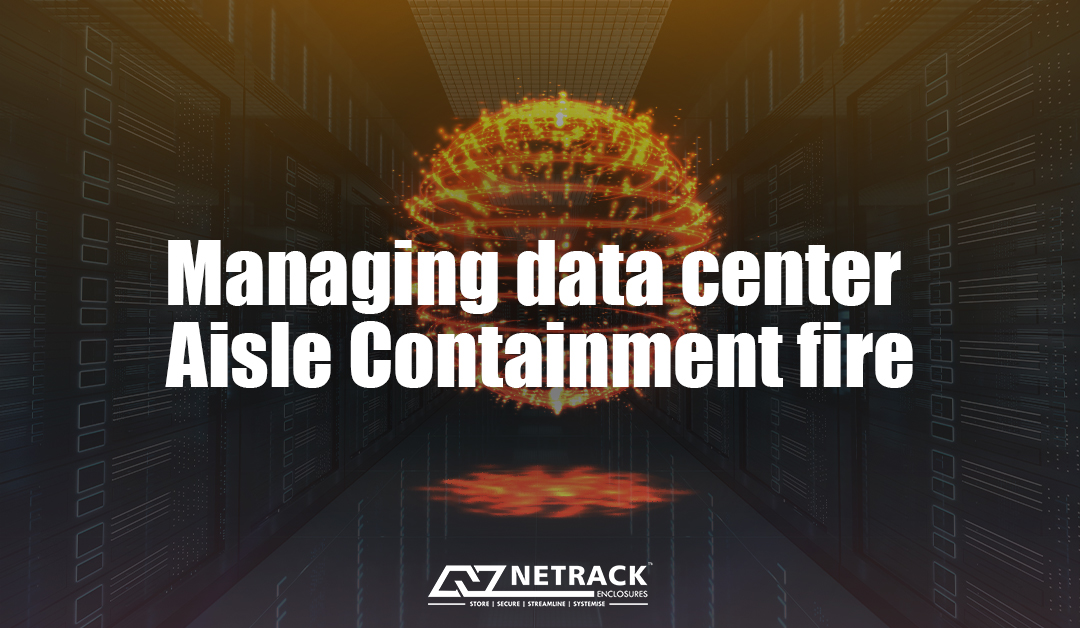
Managing data center aisle containment fire
The data center is critical to the operation of a business. Downtime or damage of any mission-critical equipment can cost heavily on the business, even to the extent of losing credibility. According to secondary research, a fire breakout at OVHcloud’s SBG2 data center in Strasbourg, France, raised concern among enterprises about the vulnerability of the data centers to fire.
Root-cause of fire
Data centers are a hub of servers, wires, PDUs, and various equipment that operate 24/7 to support the operation of the enterprise. In such scenarios, they generate immense heat that increases the data center’s temperature. Additionally, poor ventilation or improper airflow management reduces the cooling capacity of the data center causing fire outbreaks. The hard drives within modern servers require a constant and large power supply causing an overload of the circuit and overheating. Again, the overheating of equipment can result in an electrical short circuit in switches or power inverters to the ignition level.
Hence, it is evident that the chance of electrical fire in the data center is greater than anywhere else. Since such catastrophic fires at the data center are a constant cause of concern, in a data center environment, they can be identified, and the equipment isolated through continual monitoring. Hence the damage can be controlled without long-term implications.
Consequences of fire hazards
A data center fire outbreak’s consequences are precarious and alarming. Even if the fire is identified and contained, it can cause enormous damage. Due to its corrosive chemicals, smoke can damage servers, network peripheral, and business-critical equipment. In addition, exposure to flames and high temperatures can permanently damage sensitive equipment.
Considering the consequences and their grave importance, protecting the data center from such hazardous fire and smoke is necessary. Therefore, it is necessary to locate and remove any potential fire-causing factor from the server room and install monitoring devices to identify and suppress the fire.
Importance of fire detection
Fire detection is important to safeguard the data center from any long-term damage. Early detection empowers the data center to eliminate the chance of downtime. Different types of fire detection systems and devices are available for the data center industry. It ranges from intelligent and wireless smoke detectors to conventional manually operated break glass units. The detecting devices can detect heat, smoke, and carbon monoxide. Some of the devices also come with multi-sensor detectors ensuring data center safety. There are three types of smoke detectors: Ionization, Light Scattering, and Light Obscuring. Again, Carbon monoxide detectors, popularly known as CO fire detectors, trigger an alarm based on the level of carbon monoxide in the air.
However, two types of detection systems work best in a data center environment.
- Smoke sensor-based detection system: A photoelectric, or optical smoke detector, contains a source of infrared, visible, or ultraviolet light — typically an incandescent light bulb or light-emitting diode (LED) — a lens, and a photoelectric receiver — typically a photodiode which detects the Fire .
- Aspirating based detection system: The Aspirating based smoke detection system can differentiate between smoke and dust. It sucks data center air samples through small pipes and detects danger. The smoke detector system triggers an alarm based on the air sample, any change in air quality can activate the fire suppression system to extinguish the fire.
Steps to mitigate the risk
The following are the steps to ensure safety and mitigate risk.
- Maintain a suitable temperature and humidity level to reduce the chance of potential electrostatic discharge
- Ensure proper ventilation and effective airflow management to optimize cooling and prevent the build-up of any hot spots
- Ensure regular cleaning to reduce dust that acts as a potential fuel for the fire
- Check and maintain the business-critical equipment regularly to prevent any break-down
Types of aisle fire suppression systems
Several fire suppression systems are available, such as water-based heat-sensitive fire suppression systems. Once the system detects a fire or abnormal heat, the sprinklers spray water. Chemical-based fire suppression system uses chemical foam to suppress the fire. Powder-based agents and carbon dioxide fire extinguishers prevent the spread of fire.
However, clean agent gas concentration works best for the data center industry. The following are the different types of aisle fire suppression fluids available to make an informed decision while choosing the right type to protect a data center and its equipment.
- FM200: It is colorless and odorless halocarbon. This efficient and non-flammable gas is used for fire suppression, especially in a data center environment. It safeguards the equipment from damage and is safe for people to breathe when used in an enclosed space.
- Novac 1230: It is a clean agent fire extinguisher developed as a halon replacement and an alternate to hydrofluorocarbon (HFC). This fluid can extinguish fire easily among clean agents and inert gas while ensuring safety for human beings. Hence it is ideal for any data center.
Hence a conscious decision must be taken to install the apt fire and smoke suppression system to protect the servers and mission-critical equipment.




